Machu Picchu, Paradise of Birds
Now we know that the highest concentration of endemic birds are found in ecologically predictable places. This means that birds of endemic species have small populations able to withstand periods of climatic instability, only in places that were well protected against extreme weather.
Theodore Parker III, renowned ornithologist, now deceased, specializing in the South American country, said on one occasion that “Peru provides fans of bird watching, what no other country in the world” also said “Being here I felt as a child visiting a huge store filled with new and fascinating toys”. He was right.

Machu Picchu bird observatory
Peru in general, as well as the Sanctuary of Machu Picchu, has climatic conditions for hosting multiple varieties of birds, in a place where new species are discovered each year in forests and jungles of the Amazon, as well as mountains and valleys.
Peru has more than 1,800 bird species recorded (20% of the planet), of which more than 300 are endemic, also, Peru has the record for the largest number of species in one place (650 in one located area in the jungle Tambopata). And if you think it is little, also holds the record for the largest number of species seen in a single day (361 in the area surrounding the Biological Station of Cocha Cashu in Manu National Park).
For birders (birdwatchers), the Historic Sanctuary of Machu Picchu and its surroundings is a real paradise, full of unique species that inhabit fragile habitats within a variety of ecosystems, and at different altitudes. Birds that are found among the most beautiful in the world, like the cock of the rock or bird of paradise, with species that have disappeared from other places on earth, these birds are a fundamental element in the life cycles of the ecosystems of Machu Picchu.
Peru is a country with 1804 species of birds, which are species that can be found in North America and Europe combined. 120 species that can not be found anywhere else in the world, and can observe while traveling through the land of the Incas, among the locals dressed; with villages of ancient traditions, with a world-renowned cuisine, sophisticated folk art, just to name some of the fascinating experiences this unmistakable country offers. From the richest in marine species, even the longest and highest tropical mountain in the world, in the jungle of the world’s largest river, has 87 of the 104 climate zones of the world, in a country that contains both the desert more dry and the second wettest place on the planet.
Imagine seeing a beautiful Cock of the Rock (national bird) with the background of the Inca fortress of Machu Picchu. In a country where at least 42 new bird species have been described to science in the past 30 years. Of the 104 “life zones” known in the world, 84 occur in Peru. Coexisting in harmony, every imaginable types of habitats, blessed by it somehow, with an abundance of life forms, mammals, reptiles, amphibians, fish, butterflies, trees, cactus, orchids, etc.
Among the 352.590 hectares that protects the Historic Sanctuary of Machu Picchu and the surrounding mountains, they are recognized worldwide for its large number of endemic bird species (ie, that can not be found anywhere else on the planet ). These are 406 recorded species, a spectacular number considering their small size.
Machu Picchu has beautiful scenery, in addition to long walks that allow you to observe the great variety of birds, which offers its surroundings, a unique and unforgettable experience. The cloud forest surrounding the stone city is full of species of beautiful and colorful as hummingbirds (33 species) and tanagers or fruteros (48 species) also highly sought after by birdwatchers as the cock of the rock (rupicola peruviana), two species of quetzales (golden-headed quetzal and Pantisianus), 9 species of woodpeckers and nuthatches, 75 species of flytrap varieties, with spectacularly exotic birds, as the mountain watchmaker (Momotus aequatorialis), the toucan of celestial chest (Aulacorynchus coeruleicinctus), the torrent duck (Merganetta armata), the dipper (Cinclus leucocphalus), the tyrant of red rump (red-rumped bush tyrant), the finch wild brown chest (Poospiza caesar) and many others.
COCK OF THE ROCKS
ANDEAN GUAN
BLUE AND GREY TANAGER
SANTA ROSITA (SWALLOW BLUE AND WHITE)
HUMMINGBIRD CHEST BROWN
MOUNTAIN WATCHMAKER
HUMMINGBIRD WHITE BELLY
CUCARACHERO INCA
NIGHTHJAR TAIL LIRA
CARACARA OF MOUNTAIN OR CHINALINDA
MASKED PINCHAFLOR
COLLARED TROGON
DUCK OF THE TORRENTES
CLIMBER PEARLY
TANGARA OF GOLDEN COLLAR
SPARROW OF NECKLACE RUFO (PICHISANCA)
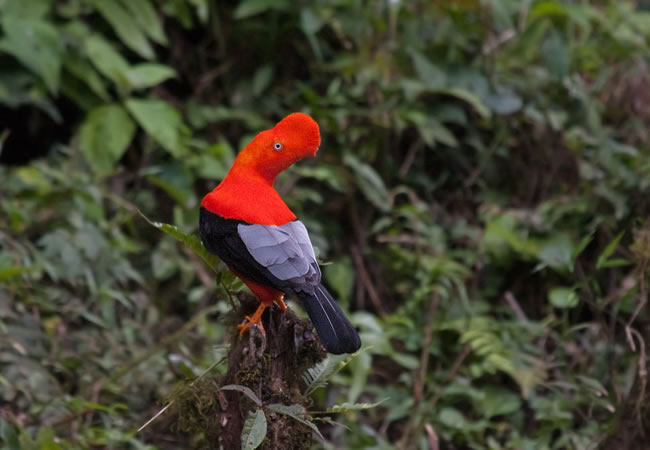
COCK OF THE ROCKS
- Scientific Name: Rupicola peruvianus.
- English Name: Cock-of-the-rock.
- Size: 31-33 cm.
- Altitude: 500-2.300 msnm.
- Hábitat: Forest montane damp.
- Other Countries: Colombia, Ecuador, Bolivia.
- Frequency of Sighting: Quite Common.
ANDEAN GUAN
- Scientific Name: Penelope montagnii.
- English Name: Andean Guan.
- Size: 53,5-58,5 cm.
- Altitude: 1.100-3.450 msnm.
- Hábitat: Forest montane damp.
- Other Countries: Colombia, Ecuador, Bolivia.
- Frequency of Sighting: Quite Common.
BLUE AND GREY TANAGER
- Scientific Name: Thraupis episcopus.
- English Name: Blue and Grey Tanager.
- Size: 16-18 cm.
- Altitude: 0-2.000 msnm.
- Hábitat: Coastal valley, montane forest, amazon plain.
- Other Countries: Colombia, Ecuador, Bolivia, Brasil.
- Frequency of Sighting: Quite Common.
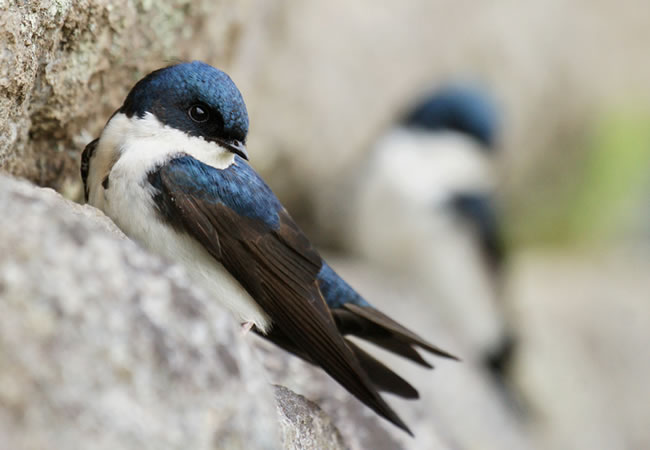
SANTA ROSITA (SWALLOW BLUE AND WHITE)
- Scientific Name: Pygochelidon cyanoleucas.
- English Name: Blue and White Swallow.
- Size: 11-12 cm.
- Altitude: 0-4.300 msnm.
- Hábitat: Andean valley and coastal, montane forest, amazonian lowlands.
- Other Countries: Colombia, Ecuador, Bolivia, Brasil, Chile.
- Frequency of Sighting: Quite Common.
HUMMINGBIRD CHEST BROWN
- Scientific Name: Boissonneaua matthewsii.
- English Name: Chesnut-Breasted Coronet.
- Size: 11,5-12 cm.
- Altitude: 1.500-3.300 msnm.
- Hábitat: Forest montane damp.
- Other Countries: Colombia, Ecuador.
- Frequency of Sighting: Quite Common.
MOUNTAIN WATCHMAKER
- Scientific Name: Momotus aequatorialis.
- English Name: Highland Motmot.
- Size: 46-48 cm.
- Altitude: 1.000-2.400 msnm.
- Hábitat: Forest montane damp.
- Other Countries: Colombia, Ecuador, Brasil, Bolivia.
- Frequency of Sighting: Common.
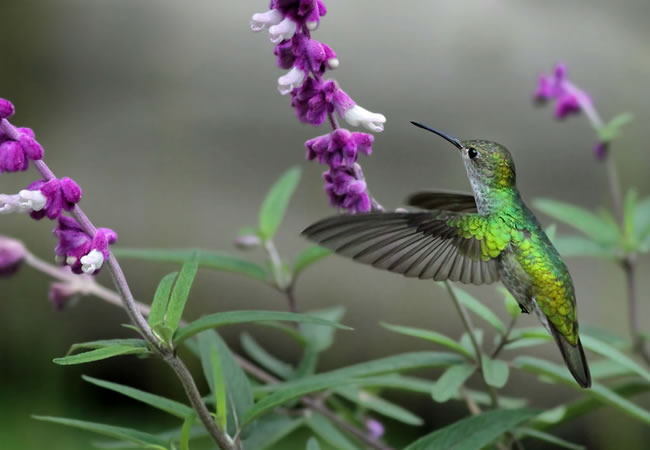
HUMMINGBIRD WHITE BELLY
- Scientific Name: Amazilia chinogaster.
- English Name: Green and White Hummingbird.
- Size: 10-11 cm.
- Altitude: 1.200-3.500 msnm.
- Hábitat: Eastern slope of the Andes, dry forests Maranon, forest montane damp.
- Other Countries: Brasil, Bolivia.
- Frequency of Sighting: Quite Common.
CUCARACHERO INCA
- Scientific Name: Thryothorus eisenmanni.
- English Name: Inca Wren.
- Size: 14,5-15,5 cm.
- Altitude: 1.700-3.350 msnm.
- Hábitat: Forest montane damp (bamboo).
- Other Countries: Endemic.
- Frequency of Sighting: Uncommon.
NIGHTJAR TAIL LIRA
- Scientific Name: Uropsalis lira.
- English Name: Lyre-tailed Nightjar.
- Size: 100 cm (including tail).
- Altitude: 1.300-2.100 msnm.
- Hábitat: Forest montane damp.
- Other Countries: Colombia, Ecuador, Bolivia.
- Frequency of Sighting: Uncommon.
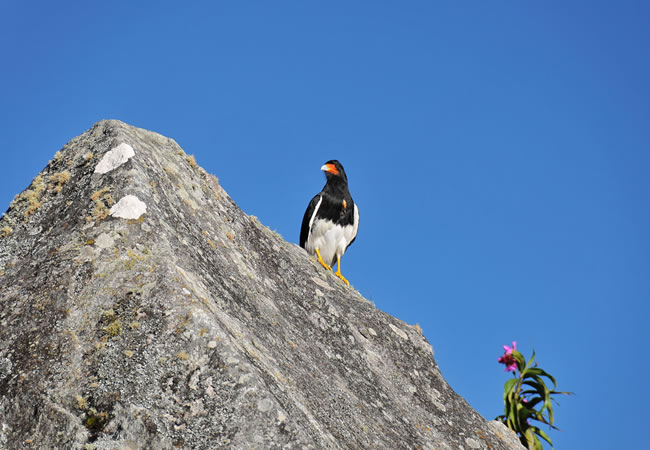
CARACARA OF MOUNTAIN OR CHINALINDA
- Scientific Name: Phalcoboenus megalopterus.
- English Name: Mountain Caracara.
- Size: 48-55 cm.
- Altitude: 3.200-4.700 msnm.
- Hábitat: Forest montane damp, puna high andean, dry forest of Marañon.
- Other Countries: Bolivia, Chile.
- Frequency of Sighting: Uncommon.
MASKED PINCHAFLOR
- Scientific Name: Diglossa cyanea.
- English Name: Masked Flower-piercer.
- Size: 14,5 cm.
- Altitude: 1.500-3.600 msnm.
- Hábitat: Forest montane damp, andean valleys.
- Other Countries: Colombia, Ecuador, Bolivia.
- Frequency of Sighting: Common.
COLLARED TROGON
- Scientific Name: Trogon personatus.
- English Name: Collared Trogon.
- Size: 25-26 cm.
- Altitude: 1.100-3.300 msnm.
- Hábitat: Forest montane damp.
- Other Countries: Colombia, Ecuador, Brasil, Bolivia.
- Frequency of Sighting: Uncommon.
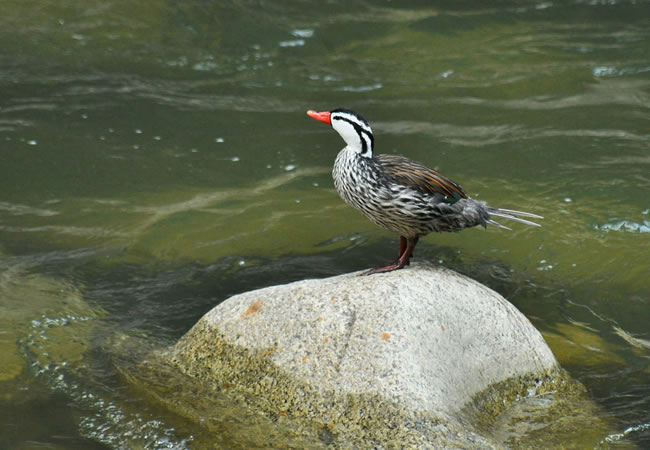
DUCK OF THE TORRENTES
- Scientific Name: Merganetta armata.
- English Name: Torrent Duck.
- Size: 38-42 cm.
- Altitude: 900-3.500 msnm.
- Hábitat: Torrential areas of rivers.
- Other Countries: Colombia, Ecuador, Bolivia, Chile.
- Frequency of Sighting: Uncommon.
CLIMBER PEARLY
- Scientific Name: Margarornis squamiger.
- English Name: Pearled Treerunner.
- Size: 15 cm.
- Altitude: 2.100-3.700 msnm.
- Hábitat: Forest montane damp, dwarf forest.
- Other Countries: Colombia, Ecuador, Bolivia.
- Frequency of Sighting: Uncommon.
TANGARA OF GOLDEN COLLAR
- Scientific Name: Iridisornis jelskii.
- English Name: Yellow-throated Tanager.
- Size: 15 cm.
- Altitude: 2.900-3.700 msnm.
- Hábitat: Forest montane damp, dwarf forest.
- Other Countries: Bolivia.
- Frequency of Sighting: Common.
SPARROW OF NECKLACE RUFO (PICHISANCA)
- Scientific Name: Zonotrichia capensis.
- English Name: Rufous-collared Sparrow.
- Size: 14-15 cm.
- Altitude: 2.0-4.500 msnm.
- Hábitat: Costa, Andes and open areas of the eastern slope.
- Other Countries: Colombia, Ecuador, Brasil, Bolivia, Chile.
- Frequency of Sighting: Quite Common.
By Ticket Machu Picchu – Last Update, 27-11-2015